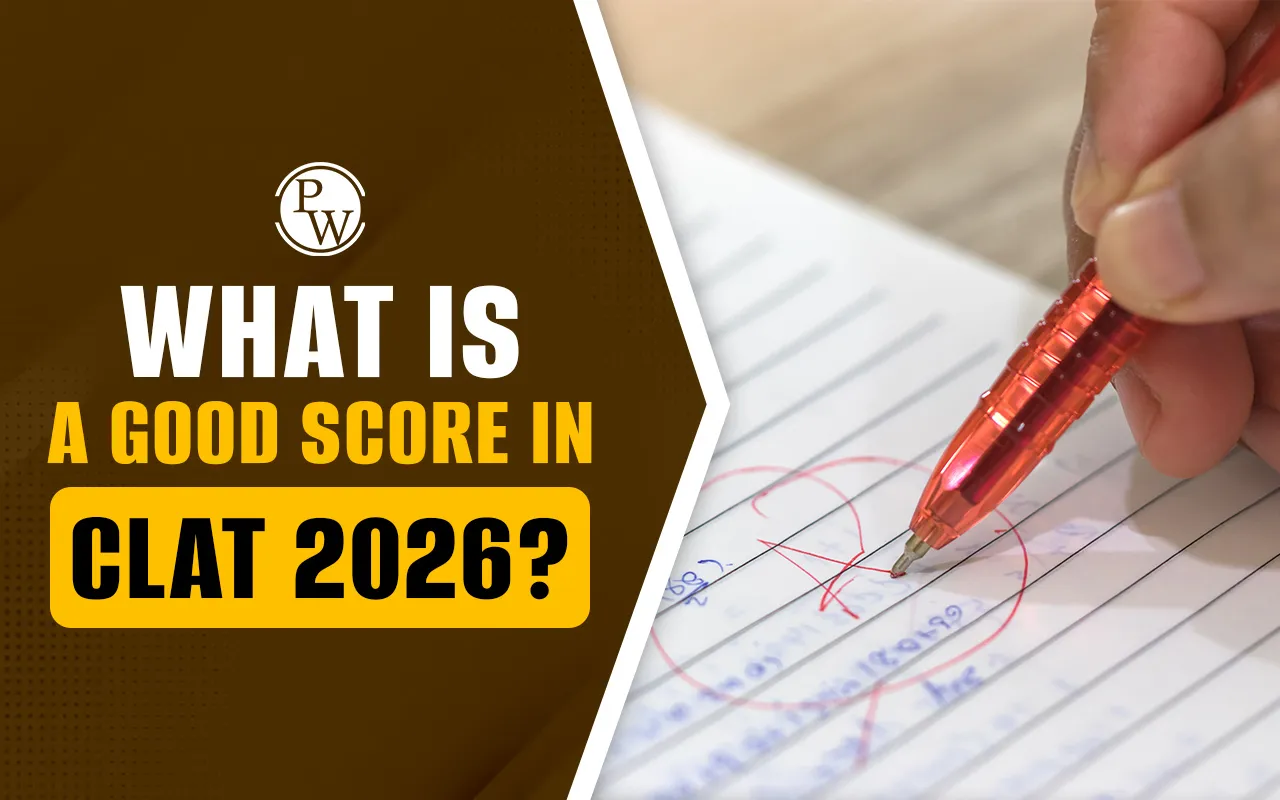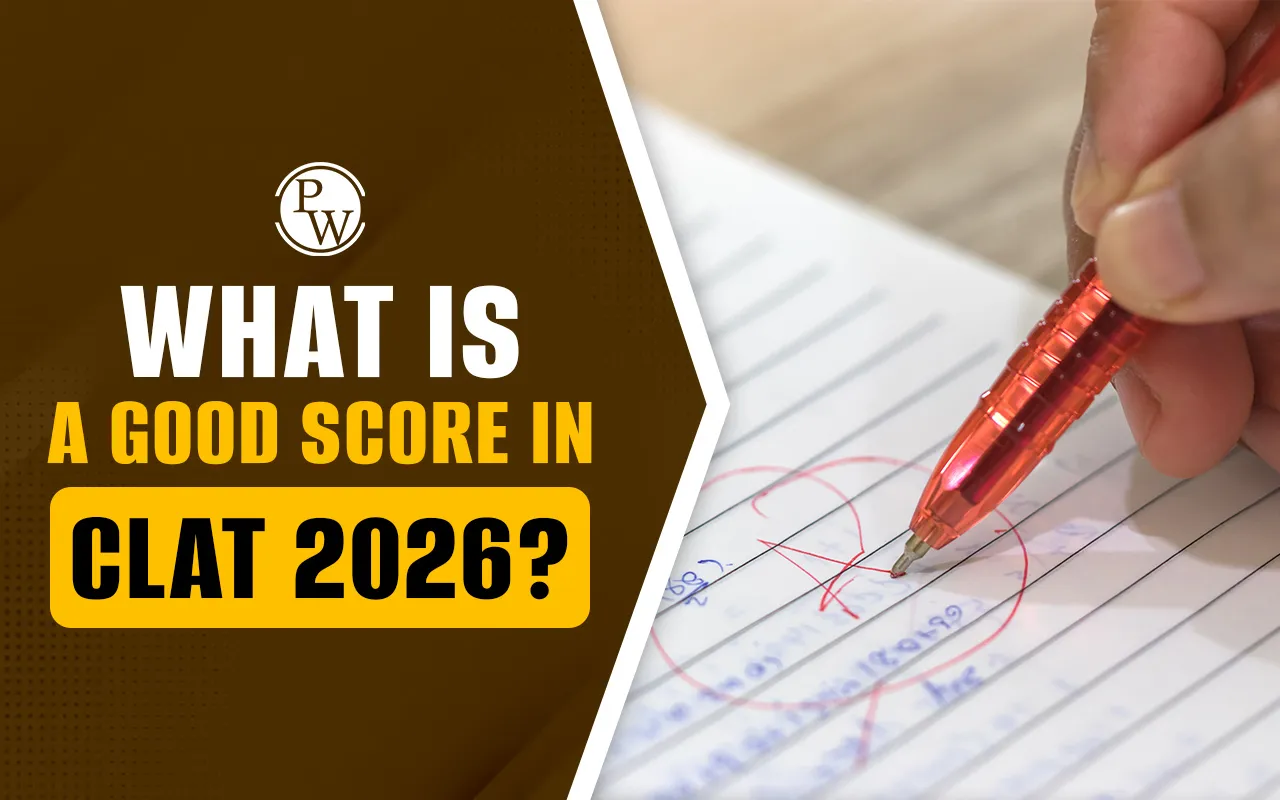

Good score in CLAT 2026 : Achieving a good score in CLAT 2026 is crucial, as approximately 50,000 candidates compete for just over 4,000 available seats. With a success rate of around 5%, it’s widely acknowledged that CLAT 2026 will be challenging. Understanding what constitutes a good score in CLAT 2026 will help candidates tailor their preparations to meet the exam's demands. Analysis of last year's results indicates that a score of 100+ marks will likely be necessary for general category candidates aiming for the top two NLUs.
In the CLAT 2026 exam pattern, the number of questions has been decreased from 150 to 120 . Admissions to NLUs will be based on a good score in CLAT 2026, so securing a good rank is essential for gaining entry into one of the premier NLUs.
CLAT 2026 Exam Pattern
The CLAT 2026 Exam Pattern is designed to assess candidates' aptitude for legal studies through a structured format. The exam will consist of 120 multiple-choice questions divided into five sections: English Language, Current Affairs & General Knowledge, Legal Reasoning, Logical Reasoning, and Quantitative Techniques. Candidates will have 2 hours to complete the exam, with each correct answer awarding 1 mark and a penalty of 0.25 marks for incorrect answers.
CLAT 2026 Section-Wise Weightage
The CLAT 2026 exam will feature a structured section-wise weightage that plays a crucial role in candidates' preparation strategies. Each section is designed to assess specific skills and knowledge areas. Understanding this distribution helps aspirants prioritize their study efforts effectively to maximize their performance in the exam.
What is a good score in CLAT 2026?
The number of questions in the CLAT exam has decreased from 150 to 120, affecting what is considered a good score in CLAT 2026. With this new format, the overall cut-offs for CLAT 2026 will also change. Previously, a score of over 100 marks (66%) out of 150 was deemed good for the general category, but now, a score of around 80% is expected to be regarded as a strong performance. Similarly, the benchmarks for other categories have also increased accordingly.
In cases where the exam is relatively easier, achieving 90+ marks may be necessary for admission to the top 10 National Law Universities (NLUs). Tier-2 and Tier-3 NLUs will have slightly lower cut-offs compared to the top ones. However, the difference in cut-off scores among the top five or six NLUs is narrower than it may seem when considering earlier cut-offs about rank, primarily due to the fierce competition among candidates.
Understanding the Prospectus of A Good Score in CLAT 2026
A good score in CLAT 2026 is expected to be around 100 marks out of 120, which is key for securing a place in top NLUs like:
- NLSIU Bengaluru: Cutoff likely over 100 marks
- NALSAR Hyderabad: Targeting scores between 98 and 100 marks
- NLU Kolkata, NLU Jodhpur, NLIU Bhopal: Cutoffs expected between 94 and 98 marks
For candidates from reserved categories, the required scores are generally lower:
- EWS Candidates: Around 85-95 marks
- OBC Candidates: Targeting 80-90 marks
- SC/ST Candidates: Looking for scores between 75 and 85 marks
What Will Be a Good Attempt in CLAT 2026?
A good attempt in CLAT 2026 can be assessed by understanding the expected performance across its various sections. The scoring potential can vary depending on the difficulty of the questions in each section. Below is a detailed breakdown of what constitutes a good attempt for each section of the exam:
Current Affairs/General Knowledge
In the Current Affairs and General Knowledge section, which is expected to be of moderate to difficult difficulty, a good attempt would involve answering 20 to 22 questions. This section tests candidates on their awareness of national and international events, making it essential to stay updated with current news and significant happenings.
Critical Reasoning
For Critical Reasoning, which tends to be easier to moderate in difficulty, a strong attempt would consist of answering around 25 questions. This section evaluates logical reasoning skills, requiring candidates to analyze arguments and draw conclusions based on given information.
Legal Reasoning
The Legal Reasoning section, also categorized as easy to moderate, is crucial for aspiring law students. Aiming for a good score in CLAT 2026 of about 35 questions is advisable here. This section assesses candidates' ability to understand legal principles and apply them in various scenarios, so familiarity with basic legal concepts can be beneficial.
English Language
In the English Language section, which is generally moderate in difficulty, candidates should aim for an attempt of approximately 20 to 21 questions. This part tests comprehension skills through passages and vocabulary usage, emphasizing the importance of strong reading and language skills.
Quantitative Techniques
Finally, the Quantitative Techniques section is expected to be moderate as well. A good attempt would involve answering around 7 to 8 questions. This section assesses numerical ability and data interpretation skills, so practicing basic mathematical concepts will aid in performing well.
Previous Years’ CLAT Cut Off Marks vs. Rank
Now, let’s examine the closing ranks and marks for general category candidates at some of the top NLUs.
- The number of seats at NLSIU Bangalore has increased from 120 to 180 , creating more opportunities for candidates to gain admission to India’s premier law school.
- Many universities now have domicile reservations. Taking advantage of these reservations can provide some flexibility with your score, allowing you to gain admission even if your score isn’t in line with the general trend.
- Last year, the minimum score for a general candidate at an NLU was 74 marks . With this as your benchmark, aim for a score of 90+ marks to enhance your chances of securing a spot in the top five NLUs.
Subject Wise Preparation Tips To Score Good Score in CLAT 2026
To excel in CLAT 2026, it is important to adopt a targeted approach for each subject. Here are some effective good score in CLAT 2026 preparation tips that can help you enhance your skills and boost your score:
English Language
- Reading Comprehension : Focus on grasping the main idea, tone, and structure of passages. Regularly reading a variety of materials can enhance your comprehension skills.
- Vocabulary : Keep a vocabulary journal to note new words you come across. Reviewing these words frequently will help strengthen your language abilities.
- Grammar : Refresh your knowledge of basic grammar rules, as many students find this challenging. Practice through exercises and quizzes to improve your skills.
Current Affairs & General Knowledge
- Key Topics : Stay updated on significant national and international events, judicial developments, and essential static general knowledge from trustworthy sources.
- Study Resources : Use reputable newspapers and current affairs magazines to keep yourself informed.
Legal Reasoning
- Basic Legal Concepts : Get familiar with fundamental legal terminology and principles to better understand legal passages in the exam.
- Practice Questions : Regularly work on legal reasoning questions to improve your problem-solving speed and accuracy.
Logical Reasoning
- Analytical Skills : Enhance your analytical thinking by tackling puzzles and logical problems. Practicing critical reasoning is also important for developing your ability to analyze arguments.
- Key Topics : Concentrate on understanding assumptions, inferences, and argument structures in passages to excel in this section.
Quantitative Techniques
- Mathematics Review : Revise topics from 10th and 12th-grade mathematics, including arithmetic, algebra, and geometry. Consistent practice with various types of quantitative problems is essential.
- Data Interpretation : Get comfortable with interpreting graphs, charts, and tables, as these are commonly featured in the exam.
General Preparation Tips for CLAT 2026
Given below are some preparation tips for candidates preparing for CLAT 2026.
- Understand each section of CLAT to plan your preparation effectively based on the weightage.
- Develop a structured study schedule that balances learning new topics, revising old ones, and practicing mock tests.
- Regularly read newspapers, magazines, and editorials to improve comprehension skills, vocabulary, and general awareness for the English and Current Affairs sections.
- Focus on topics like ratios, proportions, mensuration, and algebra.
- Regular revision of notes and key topics ensures better retention and confidence during the exam.
What Is A Good Score In CLAT 2026? FAQs
How important are mock tests in my preparation?
Should I consider coaching or self-study?
How can I manage my time effectively during the exam?
What is a good score in CLAT 2026?
What scores are considered good for SC/ST candidates?













